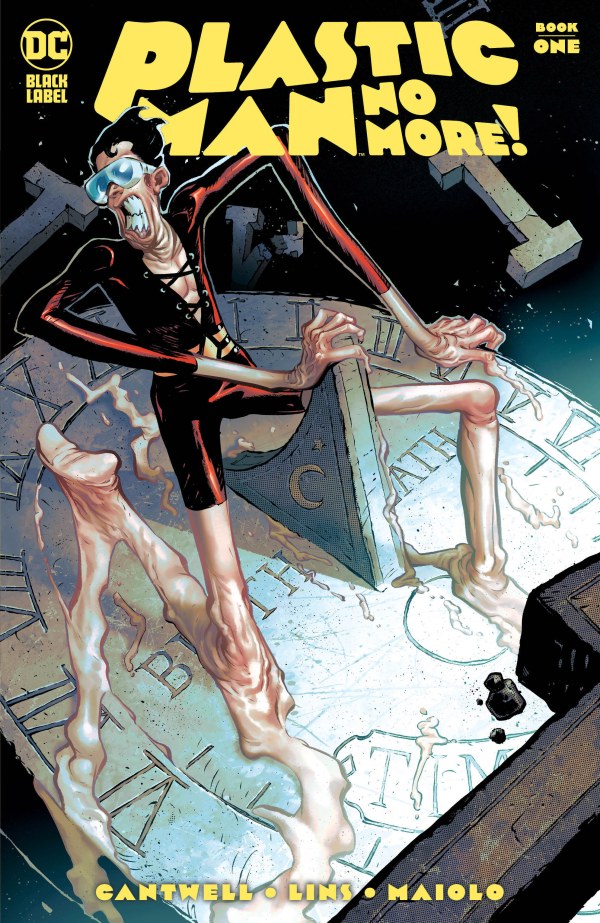Plastic Man No More! is a new DC Black Label comic series written by Christopher Cantwell about Plastic Man potentially dying as his body melts. It’s a surreal premise with a lot of potential for both introspection and body horror, and though it’s only one issue in, it’s delivering so far. DC Black Label is usually intended for more mature, out-of-continuity stories, so it seems to be a perfect fit.
This issue basically does two things: establish who Plastic Man is (including his backstory and current life) and begin the current story. As a result, the amount of stuff that happens in the present story isn’t a lot, but that feels perfectly fine. The comic still feels content-rich since it efficiently conveys quite a lot about the title character, including various different eras of his history, his relationship with his family, his relationship with the Justice League, and his insecurities and regrets. To me, it’s a mark of a great comic to be able to say a lot with relatively few pages or panels, especially if you do so using the conventions of the medium to their fullest.
Some comics lean heavily on just one or two tools, such as relying heavily on just narration boxes to tell their story, but this one takes advantage of a breadth of storytelling tools comics have to offer. For example, there are a couple instances of panel montages to convey a lot about Plastic Man’s life in just a page or two.
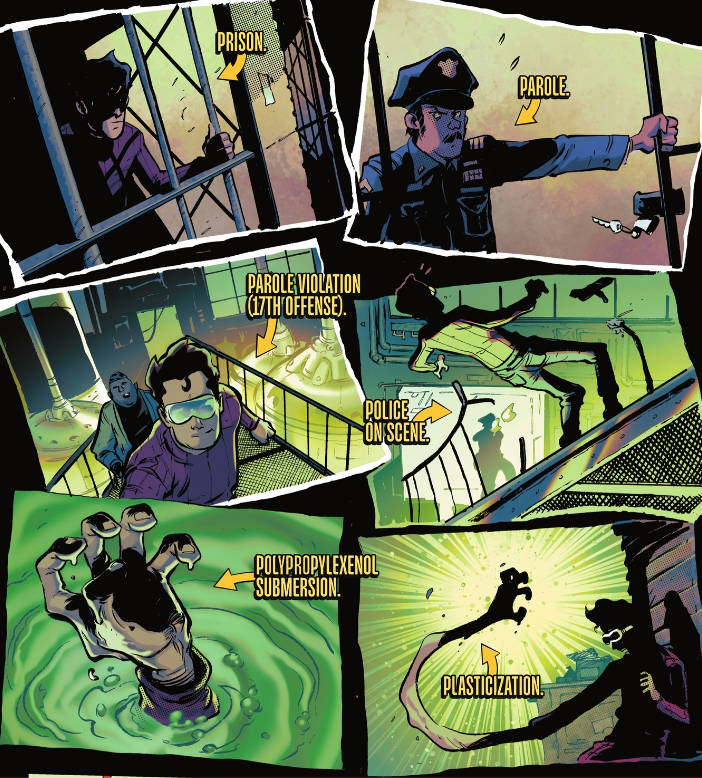
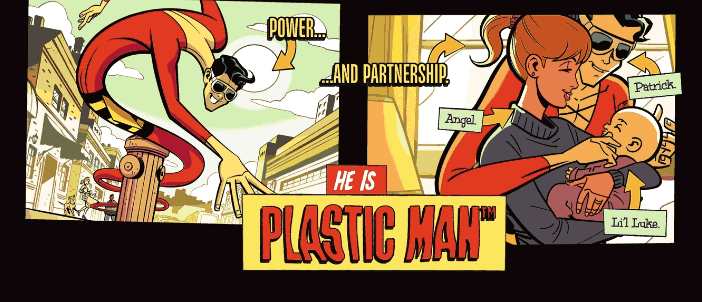
Another excellent utilization of the comic book medium is its usage of two different art styles drawn by two different artists, Alex Lins and Jacob Edgar (and a colorist, Marcelo Maiolo, using two distinct coloring styles). The main style, Lins’, has a certain roughness and dinginess with colors tending towards the dark and desaturated, while Edgar’s is clean, bright, and classic. The latter style is used for scenes with the Justice League and a couple of “happy” panels. Both styles are realistically-proportioned but a bit cartoony, especially the latter. (Cartooniness seems like a good fit for Plas in general.)
This art style contrast extends to the fact that the Justice League scenes have bright lighting (taking place outside during the day or in the well-lit Hall of Justice), while the other style is used for night scenes. It was written to ensure this wonderful visual contrast makes sense in-universe too.
What adds additional depth to this is what these styles actually signify. It’s not that Edgar’s visually light-hearted style is just for happy and light-hearted moments, as this isn’t the case at all. To the contrary, it’s used for the scene where Plastic Man receives the injury that sets his body on the course of degradation that might end him, and for him failing to get the attention of his fellow League members about his problem. It doesn’t convey genuine levity, but more the illusion of it. The League is ignorant of the situation due mainly to two things: their preoccupation with their superhero work (which is presented in a Super Friends/Silver Age-esque manner), and Plas’s own inability to stop communicating in jokes.
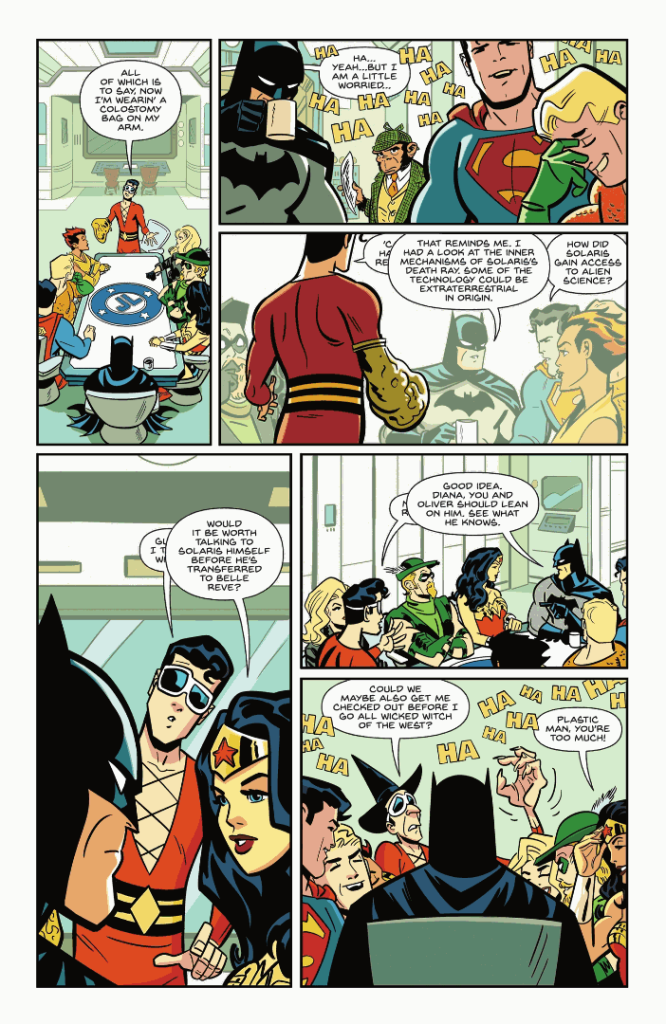
So much depth and interest is generated in a scene like this. Though the League seems oblivious and even uncaring, it’s clear that some of their reaction is also due to Plastic Man’s self-presentation. Joking almost seems like a compulsion for him, a coping mechanism built up so strongly over the years that it’s hard to stop. It makes me excited to dive deeper into Plas psychologically.
I also liked the body horror; it’s gross and disturbing but also appropriately goofy and strange. The color and texture added by the colorist certainly helps with the gross factor. The art in general is great; I particularly loved Jacob Edgar’s bright and classic art, while Alex Lins’ (the main artist) wasn’t as beautiful to look at, but was extremely effective in setting the tone and conveying emotion. All in all, this issue delivered what it promised and was enjoyable, intriguing, and dramatic, and I think this series has huge potential.
Before I end this review, I’d like to share my opinion on some negative reactions to this book.
Some Negative Reactions & My Response
To be clear, this book is receiving a great reception from many corners. I’m not claiming it’s not, nor am I trying to claim that anyone’s opinion about this book or its premise is illegitimate. I just want to mention a couple arguments against this book and why I understand where they’re coming from, but don’t fully agree.
First of all, there are some people who dislike this book’s premise because Plastic Man stories are generally more light-hearted. This isn’t “wrong”, of course; we all have our own preferences. But I guess it seems a little limiting. I actually think it’s pretty cool to find potential for a character to be used in new ways that, despite going against what that character is usually used for, still make use of their unique traits. This story is clearly leveraging the established facts about Plas despite using him in a tonally different story. It’s not a direction everyone will like, and that’s fine. But considering it’s not even an in-continuity story, I think it should be given a chance.
Even for characters who I’m more attached to than Plastic Man (I confess this is actually the first comic of his I’ve read!), I don’t like the idea of limiting superheroes too much, when many of them are actually quite versatile. For example, I don’t think the idea of Superman stories being dark or having a dour tone is inherently bad (though it needs to be done with care, of course).
I somewhat understand the fact that, since Plastic Man doesn’t have another title right now (or even a series where he appears regularly), it’s annoying to some that he finally gets his own title, and it’s not what anyone would expect a series starring him to be. But on the other hand, I don’t think there’s any reason to believe that, if this title didn’t exist, a more conventional Plastic Man series would be released.
Now to talk about the other complaint I’ve seen a bit, which I’m slightly more on board with. The characterization of the Justice League has also drawn some ire, and I get it. Their depiction isn’t flattering or accurate to their usual portrayal. But there are several reasons why this doesn’t bother me much (despite the fact that I love Superman and like the other members).
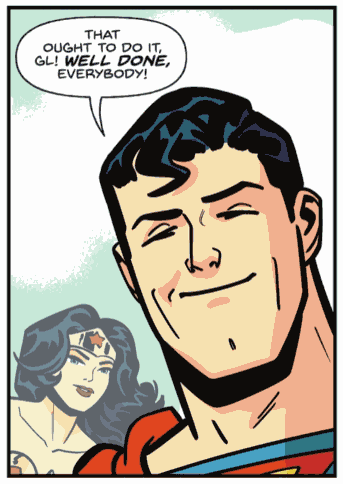
- For me, the big thing is that this is it out-of-continuity. Things don’t have to be the same as the mainstream comics.
- Especially with the above point being the case, it’s generally more important that characterization serves the story than that it conforms to canon or expectations.
- The characterization of the Justice League isn’t that bad. It’s somewhat believable that they would be too preoccupied to understand the seriousness of the situation.
All this to say, I don’t exactly disagree with the notion that the Justice League’s characterization is bad. It just doesn’t really matter in this particular context. It still annoys me a little bit, but I can accept it for the sake of the story.
To conclude, the negative reactions to this book are the kind of reactions you see a lot in fandom, especially superhero fandoms. It’s justified in many cases, but sometimes it annoys me if I feel like people aren’t being open-minded to new ideas, or aren’t thinking about the context or goals of the specific story.
